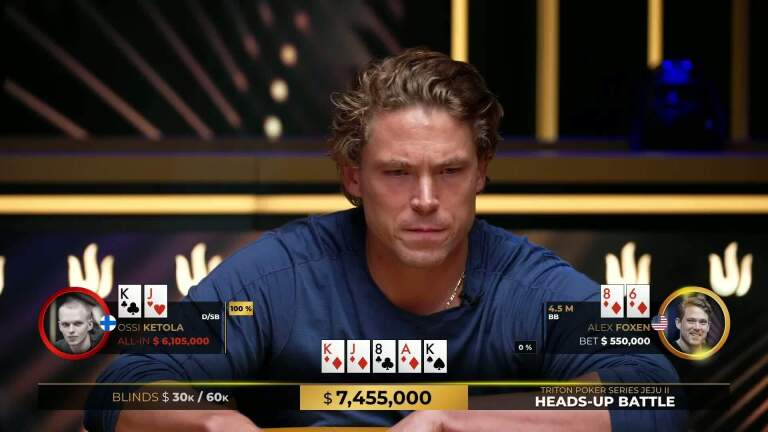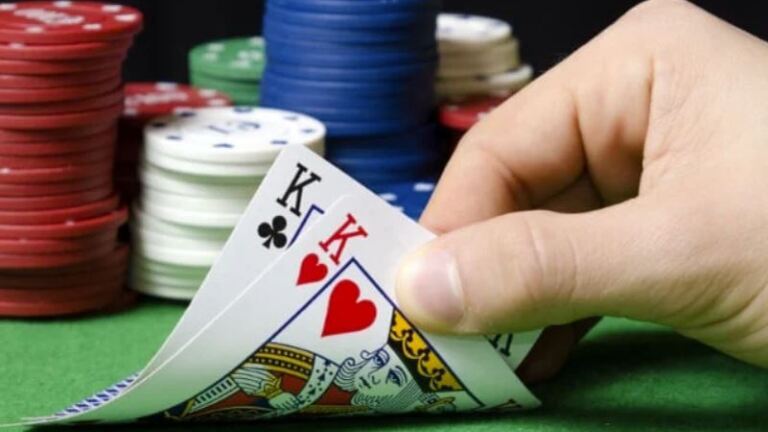7# Flop c-bet strategy from IP as you are the preflop aggressor!
Today we'll learn some basic tips for c-betting the flop. Throughout online poker's history, there were stages of this concept; first, only continual betting with EQ, later to the other extreme to c-bet 100% of the time. In this article, we dive into the reasons when, why and how to c-bet.

Understanding different board types
First and foremost, you need to understand how ranges interact and what characteristics allow you to c-bet. In most cases, the preflop aggressor will have a range and nut advantage. Hence, the BB will lack certain hands (since he would 3-bet them preflop), which can lead to extremities like c-betting our entire range or even overbetting the flop sometimes. Indeed there are a few cases when the flop is advantageous for the defender. In this situation, the BB could even donk bet the flop.
Let's see three examples of different board types in terms of comparing the ranges of the players. Because the most common situation will be BTNvBB, we'll work with the previously discussed ranges of these positions.
BTN 2,5bb opening range:

BB defend against 2,5bb open:

1. Rangebet boards
 K
K  8
8  2
2 
On this board, BTN has such an advantage that allows him to c-bet 87,6% of the time, according to GTO wizard's simulation. Above 75-80%, we can simplify our strategy and virtually always c-bet. As a result, there will be no significant EV difference; moreover, our approach will be easier to execute.
BB lacks strong holdings, such as overpairs, top sets, and strong overpairs. The best holdings will be 88, 22 and two pairs, KQ, but some of these hands are 3-betted preflop. Besides that, the board is so disconnected that BB is forced to fold a lot of air type of hand with low EQ. At the same time, BTN can easily c-bet these types of holdings.
Usually, the c-bet frequency and the sizing correlates. In most cases, the smaller the c-bet, the higher frequency we can apply. And the bigger we c-bet, the tighter range we should use. In this case, a 1/3 c-bet size is preferred.
2. Polarized strategy
Flop:  J
J  T
T  9
9

Our following example  J
J  T
T  9 is a lot more dynamic board. BB now has straights and a decent amount of two pairs as well. His range only lacks sets and overpairs, which moves the EV of the ranges closer. It would be a huge mistake to C-bet all of our hands. While checking too many hands when they need protection, while they can extract value by betting, it also would be an error. So we have to mix it up by betting a polarized range.
9 is a lot more dynamic board. BB now has straights and a decent amount of two pairs as well. His range only lacks sets and overpairs, which moves the EV of the ranges closer. It would be a huge mistake to C-bet all of our hands. While checking too many hands when they need protection, while they can extract value by betting, it also would be an error. So we have to mix it up by betting a polarized range.
In practice, we might increase our c-betting size up to 2/3 pots. We are going to bet a little bit of everything. Generally, the top part of our range we'd like to c-bet anyways. Only checkback hands if 1. you expect your opponent to be very good/aggressive, and you'd like to protect your checking range. 2. Only check back a hand that is not affected by a turn scare card (like 87 as a straight still strong enough to continue compared to T9, which is practically ruined by any K, Q, J, 8, 7 or heart on the turn). As you can see, the threshold for betting for value is somewhere in the two-pair, over-pair, and top-pair good kicker areas. In real life, against a small-stakes regular player, go ahead and bet wider until you face the aggression discussed above. You'll still be able to defend on the turn with weaker top pairs and other EQ-driven hands that are good enough to continue.
On the bluffing part of your range, you could also include a bit of everything. A good rule of thumb is the more EQ you have, the more incentivized you are to bet. Strong flush draws, straight draws to the absolute nuts, a gut shot with a backdoor flush draw, etc., are always good choices. Obviously, you cannot c-bet everything; that would lead to betting your entire range or over bluff the spot. Hands that are not drawing to the nuts might be checked back sometimes. Such as low flush draws or a pair+ flush draw which can easily continue on the turn. Doing this also helps you turn nutted hands when checking back the flop. Besides these hands, we'll have a merging part of our betting range, including hands that are unlikely to win the pot later, such as 22-44, even if they improve, like 65s, 64s, etc.
3. Boards favouring the BB
 8
8  7
7  6
6 
We must be even more careful on a board like this because it's so good for the BB. He could have hands like 95s, 87o, 76o, all the sets, and a lot of EQ with all his overcards and flush draws. So it's crucial to have a stronger checkback range, protecting ourselves from further aggression. Also, note that the board is so dynamic that almost any turn card will change the EQ of hands significantly.
So, what type of hands should we include in our checking range? We are betting with all kinds of hands, just far less often than on a board which favours us as the BTN. We need to check back overpairs, weaker top pairs, and some of the stronger draws like AdKd, AdQd, etc.
Betsize-wise, you can do a couple of things. Solvers suggest betting around 1/2 pot or even a 1/3. The reason is that, in theory, we should face a lot of aggression. This combined the number of game-changer turn cards, and we are not too incentivized to bet huge. On the other hand, your opponents won't play aggressively enough, and probably it's best to bet bigger (like 2/3 pot) with hands you were going to bet anyway.
Example
It’s folded to us on the BTN, where we’ve got  7
7  6 and we bet 2.5bb. Only the BB calls, and we see a flop of
6 and we bet 2.5bb. Only the BB calls, and we see a flop of  T
T  2
2  2 . The pot is 5,5bb, and we bet 1,8bb (as we range bet this board with a small sizing), and the BB folds and shows
2 . The pot is 5,5bb, and we bet 1,8bb (as we range bet this board with a small sizing), and the BB folds and shows  K
K  9 . Which hand had quite a lot of EQ against our current hand, but it was too weak to continue against even a smallish bet.
9 . Which hand had quite a lot of EQ against our current hand, but it was too weak to continue against even a smallish bet.
Summary
You need to read different board structures to decide what strategy to use. If you have a clear range and nut advantage, you should c-bet your entire range. The better the board for out of position, the more you have to protect your check back range and use a bigger sizing with a polarized range. Usually, the bet size correlates with the frequency you want to use, i.e. the bigger you wish to bet, the less frequently you can do it. Adjusting to your opponents is key. Most villains won't check-raise enough and sometimes overfold. Against them, you can go ahead and bet wider with a small sizing. On the other hand, you should size up and use a more polarized range if they are overly aggressive.
Please take into account that we only compared BTNvBB situations. There are far more possibilities regarding how ranges relate to each other. Think about your hand like an equation, where you might change some items. Try to apply this general guideline to each and every situation.















0 comments